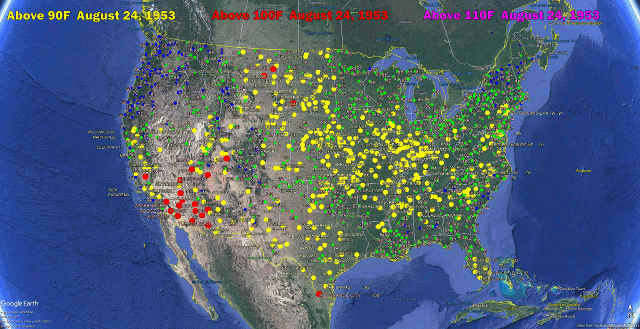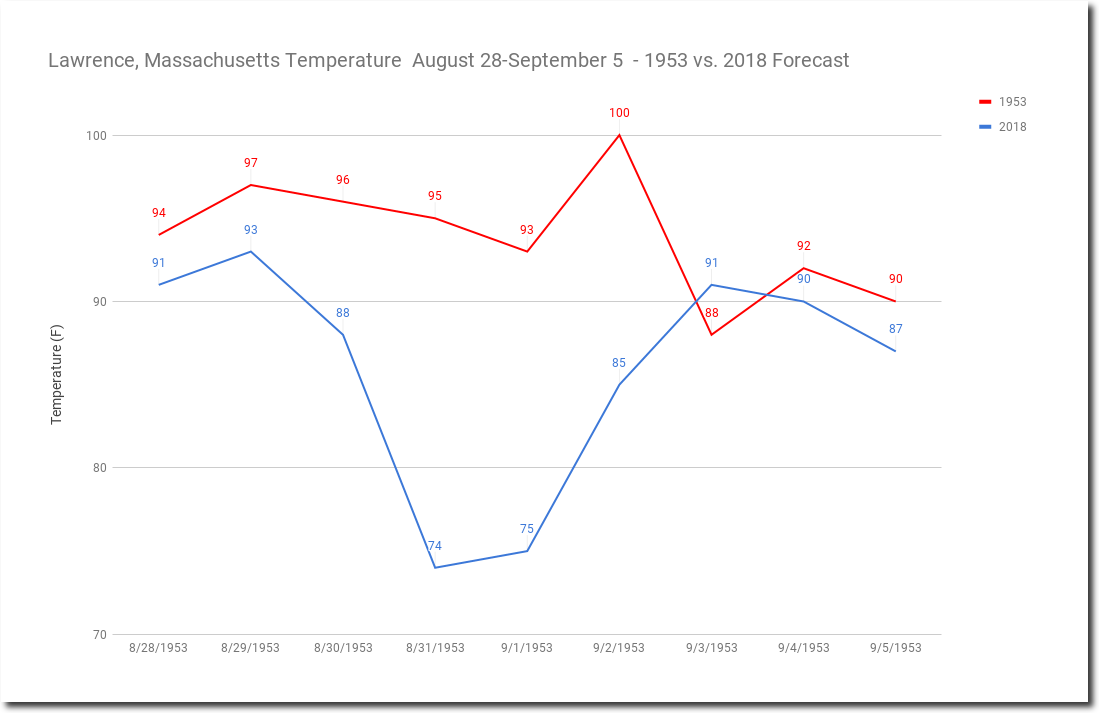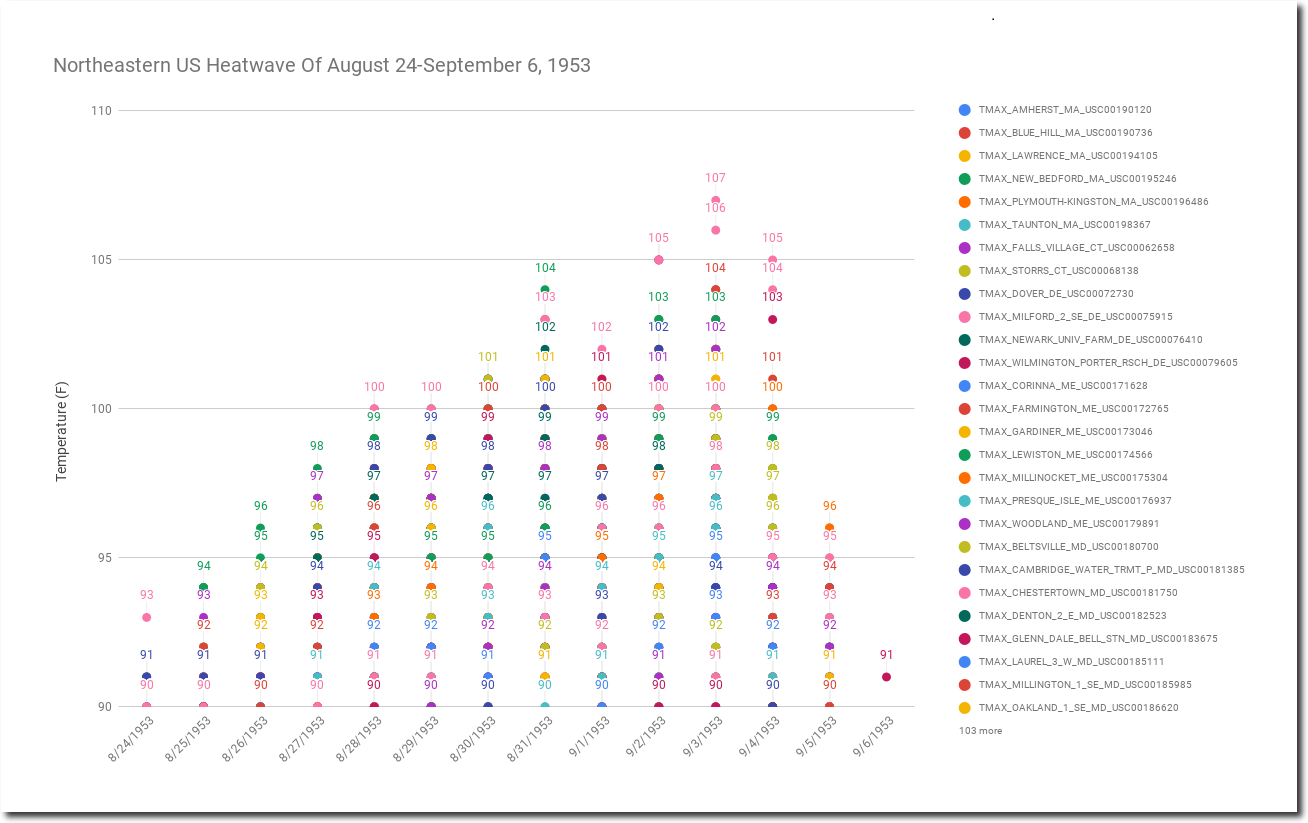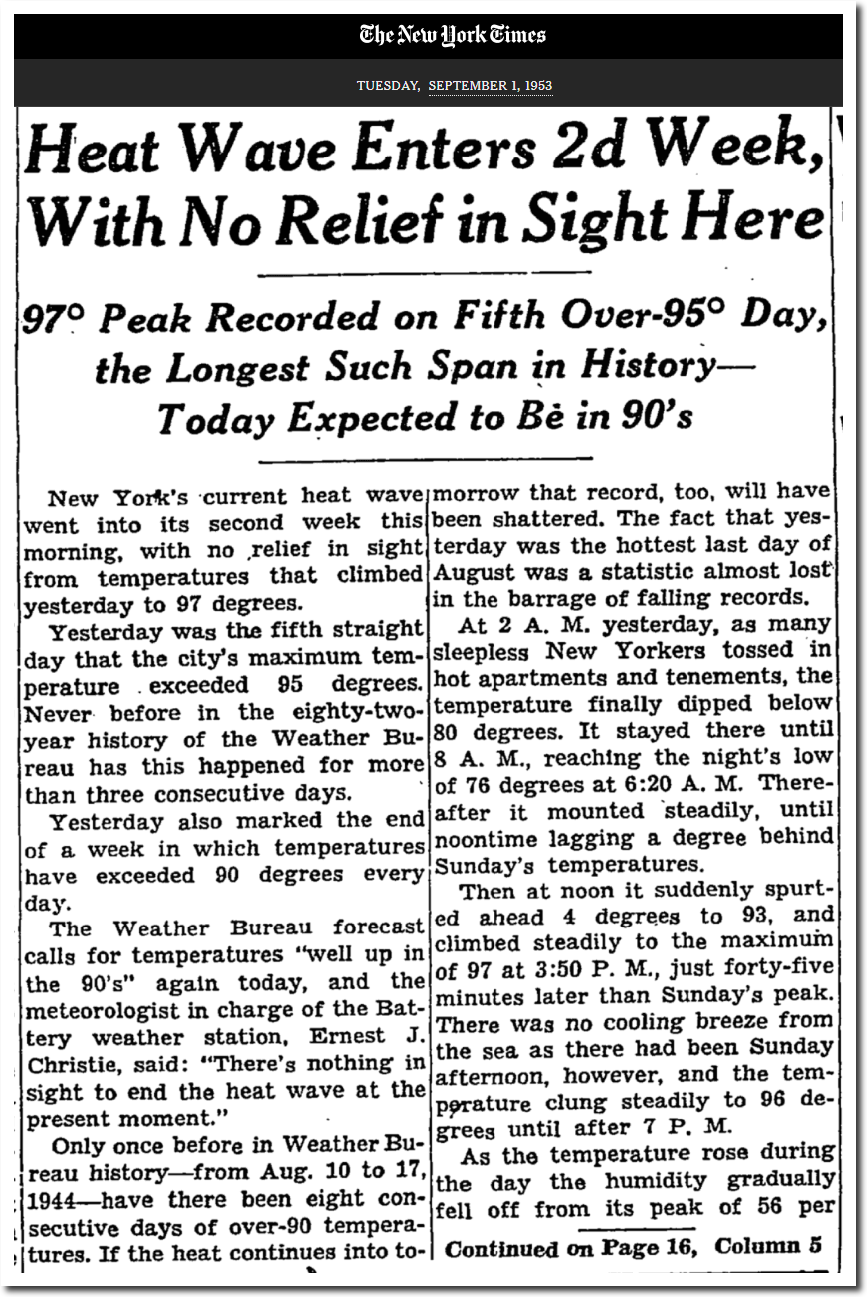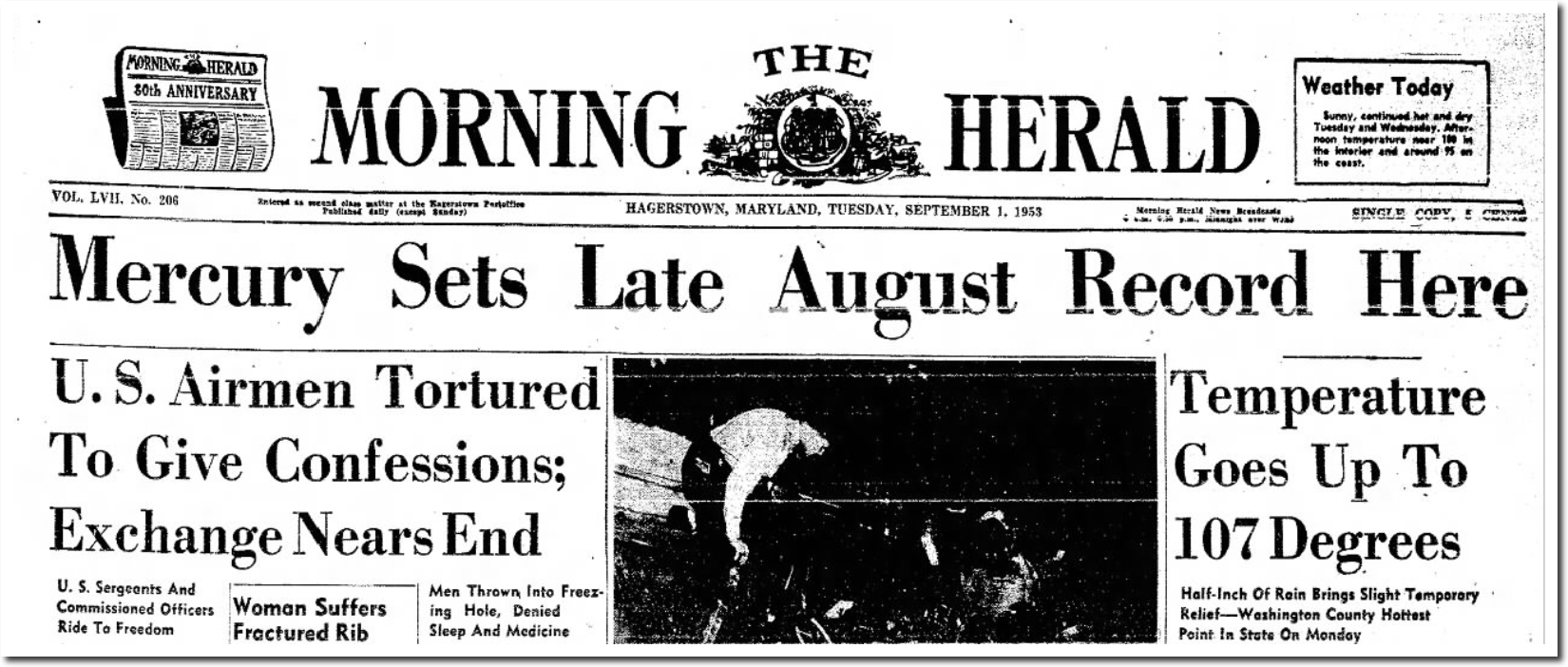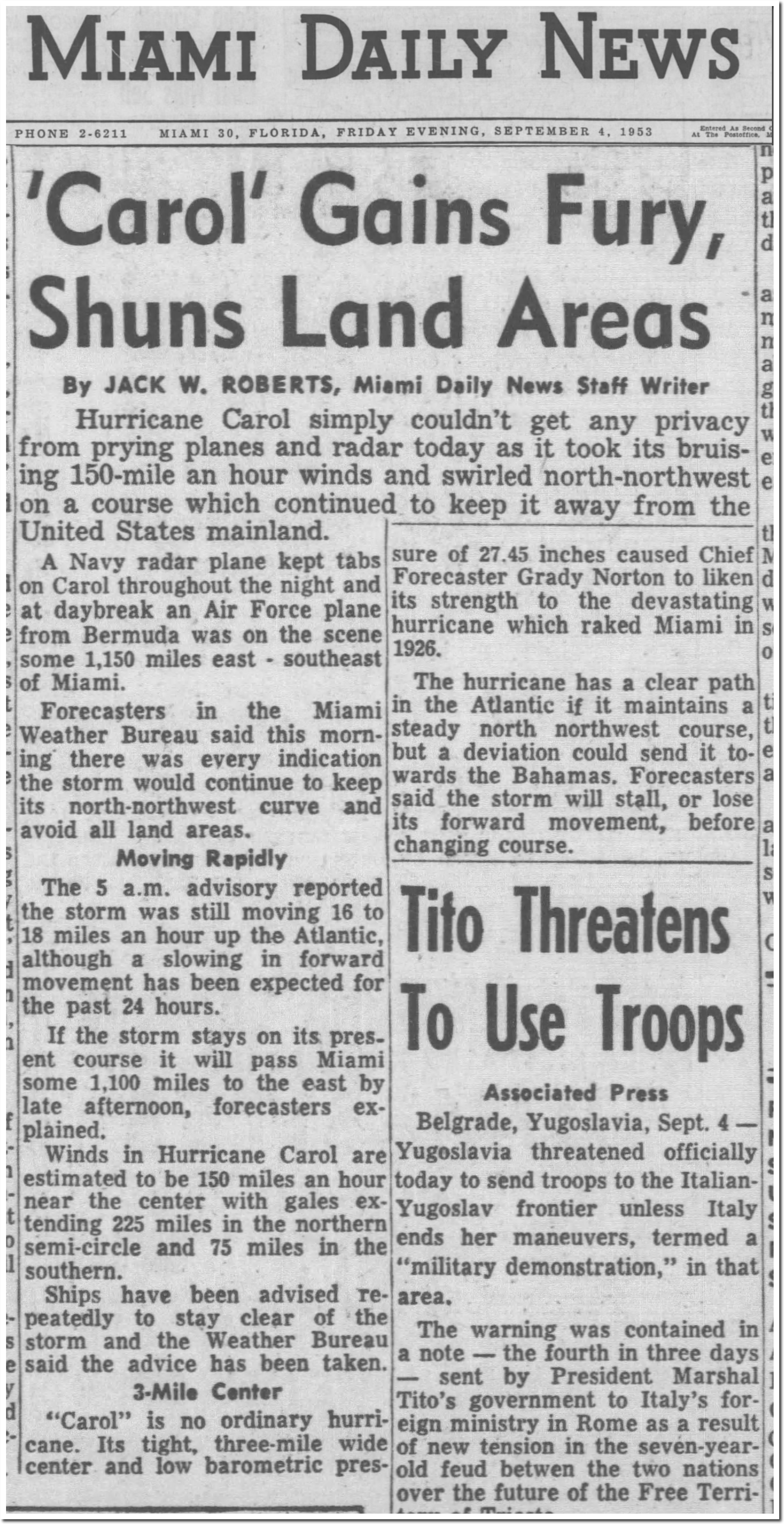The US had an unprecedented late summer heatwave from August 24 to September 6, 1953. The animation below shows the progression of the heatwave.
Lawrence, Massachusetts was eight degrees warmer than this years’ fake “record heat.”
The Northeastern US recorded 1,097 temperatures over 90 degrees, 546 over 95 degrees, and 129 over 100 degrees between August 24 and September 6, 1953.
TimesMachine: Tuesday September 1, 1953 – NYTimes.com
01 Sep 1953, Page 1 – Logansport Pharos-Tribune at Newspapers.com
It was 107 degrees in Maryland.
01 Sep 1953, Page 1 – The Morning Herald at Newspapers.com
Scores of people were dead from the heat, and communists were hacking elections.
01 Sep 1953, 1 – Star-Gazette at Newspapers.com
And Hurricane Carol was headed towards North America with 150 MPH winds.
02 Sep 1953, 1 – The Miami News at Newspapers.com
04 Sep 1953, 1 – The Miami News at Newspapers.com
If we had a repeat of 1953, climate scientists would be 100% certain it was your fault, and demand immediate world communism.
People were imagining climate change in 1953, and some scientists were (of course) blaming coal and oil.
FUNNY WEATHER WE’VE BEEN HAVING THESE PAST FEW YEARS!
WHAT’S GOT INTO OUR SEASONS?
By the Sunday Mail Research Bureau July 19, 1953
Funny weather we’ve been having these past few years! Last summer in Sydney it was so cold that ice cream sales dropped 50 per cent below normal. Melbourne had similar trouble. The seasons have become so tangled in Queensland ‘that retailers are seriously considering the alteration of traditional dates for launching seasonal selling campaigns.
Are our seasons changing? If so, why? The CSIRO has tangled with these questions and produced answers for at least the south-east portion of Australia— portion of SA, Victoria, and ‘. Southern NSW. In those regions over the past 35 years, the days have been growing cooler and the summers wetter. Researchers found that aver age maximum day -temperatures 35 years the days have been between two to four degrees lower than in a – corresponding period the year before. Summer rainfall in the South east has increased 20 to 30 per cent over , the same period. This looks a very exciting discovery until the scientists point out that a couple of decrees hardly matter a jot.
On ‘a warm day just try picking the difference be tween 79 and 81 degrees and you’ll see the point. The CSIRO people’ measured over a span of -70 years. Take a wider span of 90 years and you find that in Melbourne over the first 58 years of that period the aver age temperature was 58.5 degrees. The average over the whole 90 years was 58.5 degrees. Exactly the same! Sydney can sing; a similar song to this.- For the last 50 years average mean temperature had been 63.5 degrees, for the 50 years before that it was 63 degrees. Our seasons are changing a trifle, but only a negligible trifle.
THE GOOD OLD DAYS
WHAT makes us mistake that the change is consider able is the outpourings of old timers who remember ”end-less, sunshine’ in their youth and forget, the rainy days. That, plus the fact that the present is always far more real than the past for the rest of us. A couple of late springs, in a row will convince most people that spring has been playing up for years. To discover significant climatic change you must study centuries and not decades. Then you’ll find that the world has been slipping in and out of little ice ages’ for several thousands of years. At the moment we’re slipping out of one. The process is very slow and undramatic in any period much less than a century. Few effects are visible in Australia, but there are significant changes going on in the northern hemisphere. Europe has become about two degrees warmer in the past 50 to 100 ‘ years. The glaciers are slowly melting and receding. As a result the sea has risen 39 thousandths of an inch. This rise has also been aided by pack ice melting. . Ships can move; over the White Sea for a month more each year than they could formerly. Russia’s North -Sea lanes are now open eight months a year instead of three. In Greenland, melting ice is uncovering farms abandoned by farmers when an ice age developed in medieval times. Cod, herring, and other fish are moving far into northern waters to the delight of the Eskimoes. Sub-zero temperatures are occurring . only half as frequently in northern hemisphere cities as they did previously.
CLIMATIC MOVEMENT SINCE 1850 half the water in the Great Salt Lake in Utah, USA, has evaporated. All this represents the first big climatic movement man . has been able to measure with accurate Immediate observation. What has caused the heating up ? You can take your pick of a hatful of answers. Most popular is solar radiation—the sun getting hotter — but don’t insist on an explanation. The Danes say the sun’s heat has increased one quarter of one per cent in the last 20 years. Another theory is that centres of pressure in the atmosphere have altered, forcing warm air north to meet the ice. Johns Hopkins University experts throw up a modern novel suggestion: We’re burning two billion tons of coal and oil a year. This sends six billion tons of carbon dioxide gas into the atmosphere to form a gas envelope round the earth and to prevent heat waves that come from the sun from bouncing back again. Also, there’s the proposition that ‘ subterranean heat ‘ is’ mainly responsible..’ Heat generated from radio-active substances under the earth is ever increasing and melting rock,’ etc. Most of this heat will ultimately be released in volcanic eruptions. Meanwhile, it quietly warms the earth, melting glaciers and ice. Relatively slight temperature changes in the northern hemisphere can considerably alter climate. But to the southern : hemisphere, big temperature variations would be necessary -to make a marked difference. We-haven’t any local ice to melt. We are, however, affected by what happens to the Antarctic ice . cap to our south. This cap seems to be melting a bit at the edges at present, which probably means a little more cold water is wandering our way, and a slight difference in the temperature of winds from the south. The overall effect is very small. It is only over very, very long periods that climate varies greatly on the earth. Sixty million years ago the climate on this planet of ours was just about the same as it Is right now. Scientists told the Research Bureau they -would guarantee that calculation to within five per cent either way. A hot period kept developing for 30 million years until temperate zone; vegetation was growing in ‘What we .now call the arctic circle. The earth then iced over. It heated again until a mil lion years ago when we got another ice age of 100,000 years. The sea dropped 150 feet as water turned to snow and ice. By about 10,000 BC, this ‘cold snap’ was over. A bare 5000 years ago we got another fairly cold spell when the sea dropped only 12 to 20 feet. Since then, we’ve been experiencing small and un spectacular hot- and cold cycles. When Caesar landed In England, the climate was similar to what it is now— foggy, snowy, rainy. By 681 AD it was warm and drought-stricken. By 1400 AD England was almost ice locked. Over the last 200 years England’s average temperature has never varied by more than three degrees.
Backyard climatologists in Australia felt they were on to something big after the atom bomb exploded on Monte Bello Island last year. Although it was summer, Sydney promptly froze. Melbourne’s normally windless December turned on 60 mph gales. Tasmania registered record . rainfalls. It was too cold to swim at Perth’s surfing beaches, and Queensland suffered a freakish heat wave. This surely was climate gone crazy! There was no doubting; that point. But did the A-bomb cause the conditions? Scientific answer: To keep one moderate hurricane going you would need the energy of up to 50 atom bombs per second for a period of up to a week. They didn’t explode that many bombs at Monte Bella Anyhow, why should we complain so much about our weather and climate? Both are nearly the best in the world — this side of the next ice age. Our coldest capital city is Canberra, which averages 44 degrees in winter, and holds the record low recording of 18 degrees. Call that cold? Moscow is the coldest capital in the world, averaging 14.7 de grees. (Record low minus 41 degrees.) Ottawa is 14 de grees, London 40,. Paris 38. . And the coldest spot anywhere is the Siberian village of Verkhoyansk, which once hit 95 degrees below zero. It’s only 70 degrees below at the Pole. Coldest ever recorded in Australia was 8 degrees below at Charlotte Pass, in 1945. If your complaint is that our climate gets too hot because the average summer temperature in our capitals is 72 degrees, be grateful you don’t live in Azizia. Libya, the hottest spot on earth, where 136 degrees has been recorded. Should rain be your pet aversion we have a few spots in the Commonwealth you might well dodge. They’re well up in world class. Crohamhurst in the Blackall Range, Queensland, col-lected 35.7 inches of rain in 24 hours in February, 1893. That is just under three feet of water.
RECORD RAINFALL ONLY one other place in the world has ever beaten that effort. Cherrapunji, in Assam, where 40 inches fell in 24 hours. This same Cherrapunji also holds the record for a year — 905 inches or more than 25 yards. That was in 1861. Tully, North Queensland, holds our local record for most rain in one year — 310.75 inches (over 24 feet) in 1950. To settle that trouble-making argument about which of our capital cities has the most pleasant climate, the Bureau compared them on a points system. Points were awarded for humidity, wetness, hotness. and coldness. If one city had won in all sections, it would have had the least humidity, least wetness, and would have been the coolest in summer and warmest in winter. And it would have had a total of 24 points. No capital won in all sections. Adelaide, however, came top with 18 points. It has least humidity and wetness and was middle in the list for coolness in summer and warmest in winter Perth and Hobart both came second with 15 points. Brisbane and Melbourne were equal fourth with ’13 -points ‘Sydney ran a bad last with 10 points. Still it’s not much good worrying about the weather. We’ve got to take it just the way it comes, for nothing we can do can alter it.

